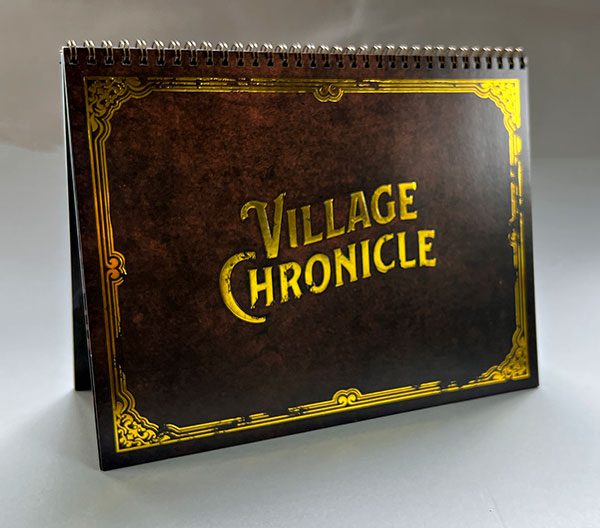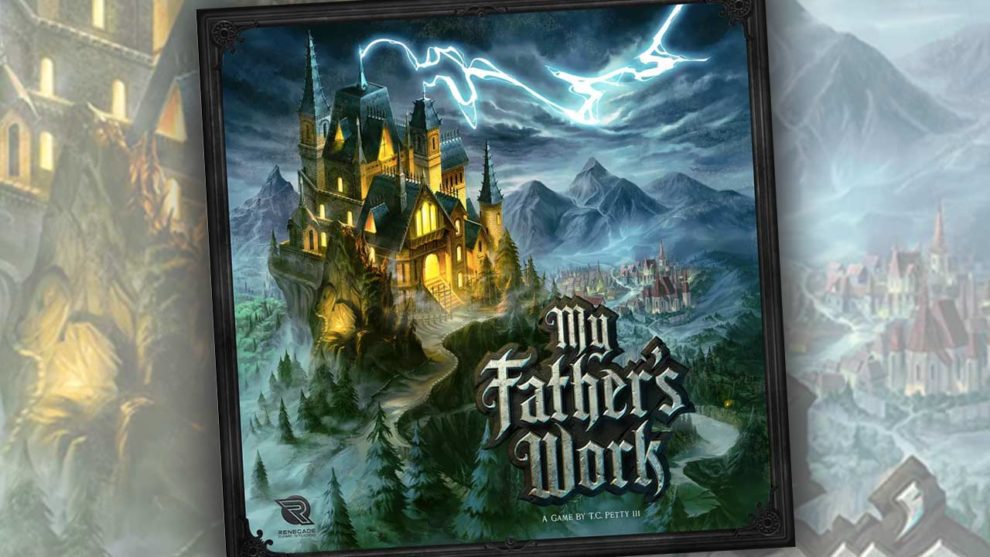Meeple Mountain first reviewed this game in 2022 with my colleague Brody Sheard’s detailed video review of My Father’s Work. Now we bring you a written review!
The box for My Father’s Work looks big, heavy, and intimidating. That’s because it is. Coming in at just over ten pounds, it is the heaviest game, by weight, in my collection. Add to that the four hours needed to complete a single game, and I would understand if your first reaction was, “Thanks, but no thanks.”
Oh, but you would be missing out on such a good game.

Allow me to open the ancestral gates to our estate and take you on a tour of My Father’s Work. Along the way, I’ll explain why this is one of the best games my gaming group has played in the last few years.
NOTE: Despite the importance and fun of the changing narrative aspects of the game, I am keeping this a spoiler-free review so you can explore the stories, the choices, and the ramifications of those choices for the first time yourselves.
We’re All Mad Here. I’m Mad. You’re Mad.
It is the early 1800s. You and your cousins, all university educated and eager to put your own scientific ideas to the test, have left the fashionable city behind to collect your inheritance: your fathers’ mansion on the outskirts of Romania. The villagers are a simple, superstitious lot, but they should at least be a source for certain…items your experiments require. And, given your aristocratic lineage, they should also leave you alone to concentrate on your work.
Discovering your fathers’ collective laboratory was a stroke of luck. Finding your father’s journal, with the notes on his scientific observations and research, was undoubtedly Divine Providence! For in that journal were sketches and plans for his Masterwork—a project you have decided that you will undertake and claim the glory for your family’s name.

Conduct experiments to score points and at the end of three generations, the player with the most points wins the game and claims their place in the annals of scientific history!
Setup
Assemble the common board area with the score tracker along the outside edge and a large, empty space in the center area. Into that center area, place the unopened Village Chronicle binder.

Each player selects a color and takes the corresponding player mat, along with the various pieces for that color.
You need six miniatures to play the game. My Father’s Work comes with six different types of characters. You can take multiples of a single type or, as I prefer, one of each.

Place yourself, your spouse, and a groundskeeper in the upper section of your player board. Your unique ghoulish markers start at the left side of the recorded knowledge track. The other three characters go into the Lost section of the common board for potential later use.

Before going any further, you need to choose a scenario to play. Each scenario presents a very different story that you’ll explore throughout the game.

Playing the Game
Once you’ve chosen the scenario, open the box and remove all the cards, chits, tiles, etc., that may be used in that storyline. Set them aside for the moment while you open the My Father’s Work app on your smartphone or tablet.

The app asks you which scenario you’re playing, then asks you to name the nearby village and your characters. Once that has been entered, you’ll be told which page to open in The Village Chronicle as your starting point. A narrative passage then provides the background for your entry into the game.
You will spend much of your game sending your people into the locations on the current Village Chronicle village page to procure the provisions necessary to conduct your experiments, and then conducting them.
Experiments come in three types, known as A, B, and C-level experiments.

The upper left corner of each experiment card shows the required items for the experiment. The bottom shows the type of experiment (left corner), the rewards for conducting it (center) and the Victory Points gained.
On a turn, you’ll either send one of your characters with round bases (spouse or servants) into town to gain a single item. You can also send yourself to town to pick up two of the chosen item.
Once you have the items listed in the upper left corner of an experiment’s card, you can send yourself or a groundskeeper to conduct an experiment. In a pinch, you can send your spouse and a servant to conduct an experiment—however, they are driven mad by what they encounter. At the end of the round, they go to the Lost section of the common board and do not come back to your player board at the start of the next round.
You can perform an A-level experiment at any point in the game, provided you have the required items and send someone to the laboratory to perform the experiment. B-level experiments require you to have accomplished an A-level experiment, while C-level experiments require you to have conducted an A-level and two B-level experiments. Completing your father’s work requires an A-level, two B-levels, and three C-level experiments.
Many B-level and all C-level experiments will require you to have certain types of Knowledge at your disposal—Knowledge gained when conducting A-level experiments. There are four types of Knowledge: Engineering, Biology, Chemistry, and the Occult. You can choose to use your gained Knowledge for a specific experiment, and then return it to the pool of Knowledge, or you can take an action to Record Knowledge. For increasing amounts of Knowledge, you can Record it, allowing it to be available for future generations to use.
Speaking of those future generations, you will only have three rounds to make the best use of your cards and actions before your current generation comes to an end. Once that happens, your current self dies, leaving behind only a single completed experiment, one unfulfilled experiment card from your hand, and any Knowledge you have recorded. Any unused money and provisions are returned to the pool of resources.
Then your descendants make their way to the ancestral castle… and discover any Recorded Knowledge left behind and, of course, their father’s work.
We’re Actually All a Tiny Bit Madder Than Before Here
As if dealing with these inferior, uncivilized circumstances isn’t enough, those pesky peasants in the village will regard you with suspicion should you acquire, oh, say, an unused body or two from the graveyard, for your experiments. Certain items and experiments will ‘reward’ you with that same suspicion, which pushes you to the right on the Creepy track, closer to the Angry Mob in the village. Others push the Angry Mob to the left, closer to you. Should your Creepy track token and the flaming pitchfork of the Angry Mob ever meet on the same space, they will put a stop to your visits to the village.
Unless, of course, you send someone to The Church and convince the Angry Mob otherwise. These country folk are so easily swayed one way or the other.

And then, then, there’s the Insanity Track. Insane?! Not I, my friend! It is only that my genius is misunderstood by those backwoods imbeciles in the village! And my cousins? Why those pretentious fraudsters are clearly jealous of my progress! No, only I and I alone can comprehend what my advancements mean both to science and for the glory of my family name. No—to MY name! Yes, my name and my name alone!
Ahem.
Some experiments reward you with advances on both the Creepy and Insanity tracks. Go too far on the Insanity Track and you’ll pick up a Compulsion card. Compulsion cards list an action or event that you’ll need to complete for an extra point or two. Fail to complete two of them before the current generation ends and you’ll get a Maladjustment card that openly affects your characters for the remainder of the game, carrying over from one generation to the other. And they are always bad.
We All Live in a Network of Stories
So far, Mad Scientisting aside, this has all been standard Worker Placement/Resource Management stuff: send out workers to acquire resources of various types and exchange the items for something that will gain you points.
However, where My Father’s Work shines the brightest is in the narrative decision trees behind the three stories.
Remember those three scenario boxes and the app? They work together to expand and contract the game as time passes. There will be events in the Village that your family will be drawn into, events that will force you to make decisions. Do you support this group or that group? Do you trust this person or not?
The narrative choices are a part of why I like My Father’s Work so much. While many games purport to tell a story, this game not only tells a story, but requires your involvement by making decisions—choices that are not just superficial, but impact and change the story for the remainder of the game.
Those ramifications will also affect your environment. The Village Chronicle contains many different maps of the village where you’ll be sending your people to collect the necessary resources for your experiments. That nice starting village with all the supplies you’ll need will soon be replaced by other maps—some with additional spots, many with far fewer.
Our choices have led us through only a sampling of the village maps. Some were helpful, some frustratingly unhelpful, and one that was cataclysmic. Each map, however, made complete sense in the context of the story and our decisions.
Each of the three scenarios has eight different possible endings. Eight. From a storytelling perspective, that’s a fine accomplishment. Marry that up with a good board game and you have some serious replayability.
Put the Message In the Box
I am not a fan of Unboxing videos and rarely go into the quality of a game’s pieces in this much detail, but you really should see how great the components are here.

During the game, players will be acquiring and spending Provisions to conduct experiments. Everything fits in this GameTrayz holder. The bottles used to represent Chemicals are each glass with cork stoppers; the money is weighted metal; there are several types of metal gears; the coffins and animals are thick plastic.
My Father’s Work has spoiled me. Now I want all my games to look and feel this good when I pull them out of the box.
The Bad, The Good, and The Mad
For all this, My Father’s Work is not a perfect game.
The narrative sections can run a bit long at times. You’ll have the choice of a male or female narrator to read you some of the sections, but they tend to read them fairly slowly. This became an issue for my group, so I turned the volume off and read the text aloud fairly quickly.
There are some reported bugs in the app, bugs that have, unfortunately, not been addressed through an update as of this writing. My group ran into one of them, part way through one of our games, and while it was frustrating, it didn’t distract us for too long. (I understand there are more serious problems with the French translation of the app, however.)
Also, while this is a worker placement/resource management game, much of your success or failure in the game will be driven by the Experiment cards. This card-drawing aspect means there is some unavoidable luck involved. In our six games thus far, two of us have each been hit with continually bad draws: the cards we drew (and drew and drew) did not offer us the proper types of experiments for the specific types of Knowledge that we needed to work towards Our Father’s masterpiece. Those Works are worth 20 +/- points, so they’re almost necessary in order to win. I wish there was some way to trade one type of Knowledge for another.
The four hours required to play the game can be daunting. It was the largest factor in my mind when I approached my group to take the game on. The teach took longer than expected, in part because I wasn’t clear on how the narrative aspects of the game through the app were going to change things. After the teach, we played through the first generation of a game just to get a feel for how the game came together.
Our first full game took us close to 4 ½ hours to play. We were so intrigued by what we’d just experienced that we all agreed we wanted to play through all three scenarios. After that third game, we agreed to replay each scenario again to see how different choices might affect the endings.
Part of that decision was based on the many, many things in each of the scenario boxes that we did not get to add into the game. Then, after the second playthroughs, there were still a lot of items that we had not touched. What are they for? Which decision needs to be made in what way to get to that part of the story? Maybe we should give each scenario another few tries?
So, even though we’ve moved on to other games, we’re all eager to return to My Father’s Work and replay them all again. And that, I think, is one hallmark of a well-designed, creative game.












Add Comment